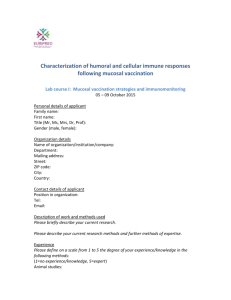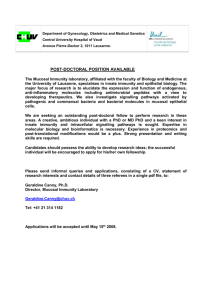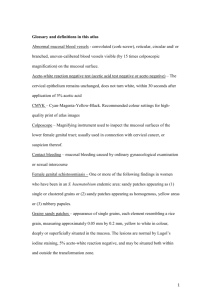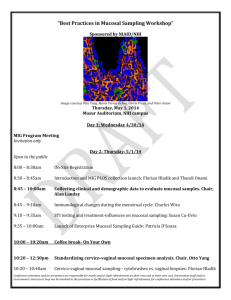The Immune status of patients with S. pyogenes Tonsillitis
advertisement
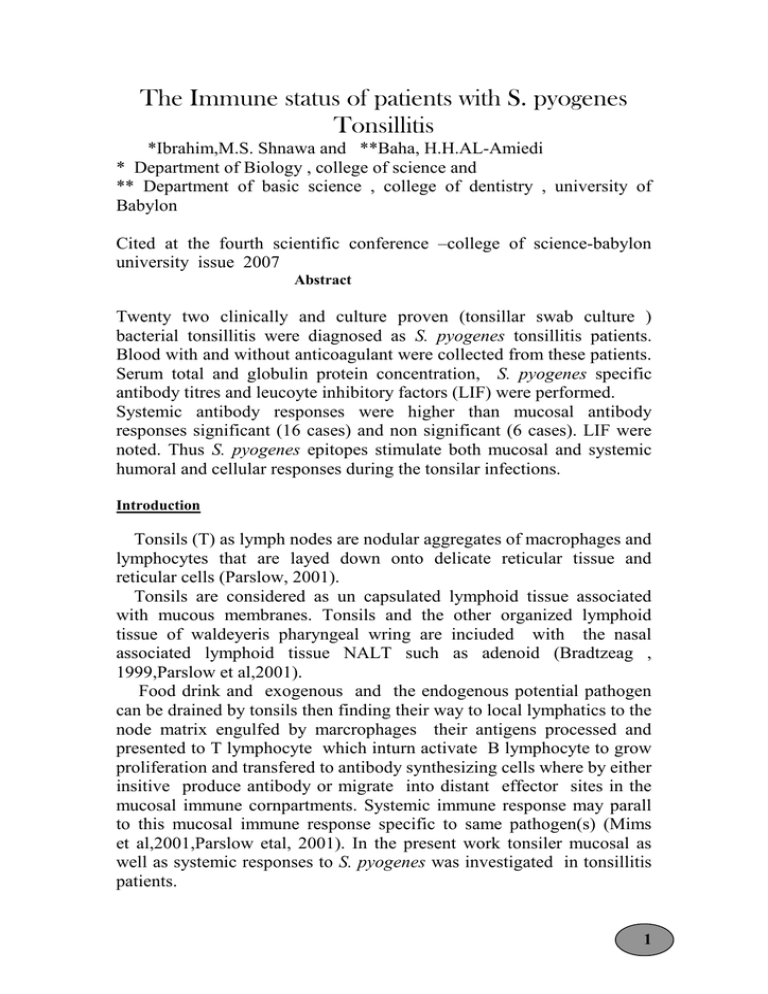
The Immune status of patients with S. pyogenes Tonsillitis *Ibrahim,M.S. Shnawa and **Baha, H.H.AL-Amiedi * Department of Biology , college of science and ** Department of basic science , college of dentistry , university of Babylon Cited at the fourth scientific conference –college of science-babylon university issue 2007 Abstract Twenty two clinically and culture proven (tonsillar swab culture ) bacterial tonsillitis were diagnosed as S. pyogenes tonsillitis patients. Blood with and without anticoagulant were collected from these patients. Serum total and globulin protein concentration, S. pyogenes specific antibody titres and leucoyte inhibitory factors (LIF) were performed. Systemic antibody responses were higher than mucosal antibody responses significant (16 cases) and non significant (6 cases). LIF were noted. Thus S. pyogenes epitopes stimulate both mucosal and systemic humoral and cellular responses during the tonsilar infections. Introduction Tonsils (T) as lymph nodes are nodular aggregates of macrophages and lymphocytes that are layed down onto delicate reticular tissue and reticular cells (Parslow, 2001). Tonsils are considered as un capsulated lymphoid tissue associated with mucous membranes. Tonsils and the other organized lymphoid tissue of waldeyeris pharyngeal wring are inciuded with the nasal associated lymphoid tissue NALT such as adenoid (Bradtzeag , 1999,Parslow et al,2001). Food drink and exogenous and the endogenous potential pathogen can be drained by tonsils then finding their way to local lymphatics to the node matrix engulfed by marcrophages their antigens processed and presented to T lymphocyte which inturn activate B lymphocyte to grow proliferation and transfered to antibody synthesizing cells where by either insitive produce antibody or migrate into distant effector sites in the mucosal immune cornpartments. Systemic immune response may parall to this mucosal immune response specific to same pathogen(s) (Mims et al,2001,Parslow etal, 2001). In the present work tonsiler mucosal as well as systemic responses to S. pyogenes was investigated in tonsillitis patients. 1 Materials and Methods Twentity two ,clinically diagnosed male and femal tonsilitis patients were the attendance of Hospital Maternity and Children in Babylon provinc during oct-2006- march 2007.The patients tonsils were swabed by cotton swabs following standardized techniques ( Crucishank et al 1975).The swab samples were processed for direct and broth pretreated Primary swab cultures onto blood agar and MacConky agar plates (Shnawa and AL-Amiedi, 2004, Crucishank et al 1975). These swabbed cultures were incubated at 37 C for 24 hrs. The suggestive Streptococcus- like colony morphotypes on primary plate blood agar cultures were purified in pure culture isolates form . These isolates were tested for hemolysis , motility , catalse, oxidase bactracin & optchin sensitivity , and hydrolysis of esculine using convenctional biochemical test ( Macffdin,2000).Blood samples with and without anticoagulants were collected from each patient for separation of sera& agglutination test as well as capillary migration inhibition of leucocytes respectively( Garvey et al 1977). 30% or higher inhibition scored as significant ( Soberg , 1968).Leucocytes were separated from tonsillar swab using dextran separation method using 30% solution (Metcalf et al, 1986) .then used to load capillaries for capillaries migration inhibition test of mucosal leucocytes .The peripheral blood and mucosal leucocytes inhibition factor (LIF) by capillary method (Soberg , 1968). The following equation was used for measuring LIF. LIF = Area of migration with sensitizer Area of migration with saline X 100 A 30 % or higher inhibition of leucocyte migration was scored as significant. The protein concentrations were determined for sera and mucosal globulins (Bishop et al , 1986 ). Results I. Infection: Direct swab smears showed streptococcus, like bacteria with Neutrophil, Monocytes and lymphocyte infiltration Direct and indirect swab cultures showed pin point colonies occupied two- third or whole of primary plate culture on blood agar plates and not MacConkey with beta haemolytic colonies are catalase ,non motile and oxidase negative bactracin sensitive and optochin sensitive and the hydrolysis of escoline was negative Thus ,the infection form was of an acute type and monomicrobic .It wase consistant with S. pyogenes.( Table- 1). 2 II. Globulin concentrations There were three concentration levels for mucosal globulins were noted among tonsillitis patients. First , low as 0.4- 0.49g/L (three patients), second, moderate levels 0.5- 0.79g/L (13 patients) and high levels 0.8- 1g/L (two patients ). Likewise, three concentration levels for serum globulin concentration were also noted as low 30- 35g/L (three patients) moderate 36-45g/L (17 patients) and 46-50g/L (two patients) when the patient globulin concentration is low it is for both mucosal and serum and if it is high it is high for both. III. S. pyogenes specific antibodies: Both serum and mucosal proteins were biurate positive, well separated by PEG 6% 6000, form colloidal solution in distelled water, homegenous moderatelly opoque on light pass. Mucosal globulin was resistant to 2ME. Mucosal S. pyogenes specific antibodies were with titre range of 8-64. that parallels 80- 640. in the systemic titres (Table- 2). IV.Leucocyte Inhibitory factors (LIF): Significant LIF were noted with ranges of 0.5-0.68 both in mucosal and systemic in 16 patients. Non significant in either of systemic or mucosal in two patients.Non significant LIF at both of systemic or mucosal in four patients 0.7-0.75. (Table-3). Discussion Exogenous and/ or endogenous S. pyogenes (Mims et al,2000,Macffadin ,2000). potential pathogens reaching throat are drained into tonsils via lymph (Southgate et al 1997: Brooks et al 2004.). They are phagocytized, their antigens proccssed,then presented either to B or to Th2 or Th1 lymphocytes, insitue in tonsiler tissue (Tabel-1) or in distant mucosal effector site (Parslow et.al 2001). S. pyogenes (paragraph I) can be of B lymphocyte and/or Th2 epitopes types will triggar mucosal and systemic (Table 1 )humoral immune responses (Brandatzaege 1994) while other epitopes of S. pyogenes\ can be of Th1 activatior,potential among which Tdth subsets that induce delayed type hypersensivity as indicated by significant LIF result in 16 patients (Table-3). Thus, S.pyogenes induce humoral and cellular immune responses both at mucosal and systemic levels (Zoblcr 1998, Soberg, 3 1968).The non significant LIF results were matched in aged patients(Bloom , 1982; Mims et al ,2000; Shnawa & AL-Amiedi,2004) On the basis of the results presented in paragraph I, table 1&2. The major immune features tonsilitis patients are i. The infection was acute monomicrobic. ii. The tonsillitis pathogen is S. pyogenes. iii. The S. pyogenes immunodom epitopes may be either one or more they can be of B cell, Th2 or Th1 dependent. iv. S. pyogenes. stimulate mucosal as well as systemic , humoral and cellular immune responses. Table- 1 .The S. pyogenes isolate characteristics Criteria 1-Microscoppy reaction Result & Inflammatory Gram positive cocci ,in chains. The inflammatory cells are basically as Neutrophil, some were with Monocyte and / or Lymphocyte. 2-Growth Aerobic 3-Colony -Morphotype Pin- heald B-hemolytic colonies on blood agar 4-Biochemical and Physiologic tests Motility Non-motile in semi-solied media Catalase Negative Oxidase Negative Esculin hydrolysis Negative Bacitracin Sensitive Optochin Resistance 4 Table 2: S. pyogenes. Specific antibody response in tonsillitis patients. No. f Patients 4 5 10 3 Antibody Titrce Mucosal (M) Systemic (S) 8* 16 32 64 80** 160 320 640 S/M ratio 10/1 * 2ME resistant S= systemic ** IgG responses M= mucosal Table -3 : Leucocyte inhibitory factor in systemic and mucosal leucocytes among tonsillitis patients. Result Significance LIF Range Mucosal Systemic Patient Mucosal Systemic Number 0.5-0.68/ 0.5-0.69 S S 16 0.7-0.72/ 0.5-0.68 NS S 1 0.5-0.68/ 0.7-0.72 S NS 1 0.7-0.75/ 0.7-0.75 N.S. N.S. 4 S= significant, NS= Non significant. 5 References 1234- 56789- 1011- 12- 13- Bishop, M.C.; Dben- Von, J. and Fody, E.P. 1986. Clinical Chemistry, Murray Printing Company, Philadelphia, 180. Brooks, G.E.; Butel J.S and Morse, S.A.2004. Medical Microbiology 23 rd ed. MaGraw. Hill, Boston. Brandatzaeg, P. 1994. Handbook of Mucosal Immunology, San Diego, Acadmic press. Cruickshank, R.; Duguid, J.P.; Marmoin, B.P. and Swain, R.H.A1975. Medical Microbiology 12th ed. Vol.2. Churchill- Livingstone, London. Garvey, J.S., Cremcr, N.E. and Sussdorf,D.H.H press 1977:Methods In Immunology, penjamin Reading. Johnstone, A. and Thorpe R. 1982. Immunochemistry In Practice. Black well Scientific Publications, Oxford. Mecffadin 2000. Biochemical Identification of Medical Bacteria 3rd ed. Lippincott- Williams Wilkin Co- Baltimore. McCoy, A.M. and Kenndy E.R. 1969. Autogenous Vaccine therapy in staphylococci infections. JAMA .174:35-38. Parslow, T.G.; Stites, D.P.; Terr, A.I and Imbodem, J.B. 2001. Medical Immunology 10th ed. Lange Medical Publication NewYork. Shnawa, I.M.S. And Al-Amiedi, B. H. H. 2004. Immunology of E. coli persistent pyuria. Med. J. Bab. 1 (3&4). Soberg, M.1968. Invitro Migration inhibiotim of pheripheral blood leucocyte in delayed type hypersensitivity Acta. Med. Scand. 184:325. Southgate, L.; Lockie, C.; Heard, S. and Wood, M. 1997. Infection, Oxford General Practice Series 40. Oxford Medical Publications, London. Zobler, R.H. 1998. Antigens, T dependent and independent. In Dalves, P.J. and Roitt, I.M. (eds) Encyclopedia of immunology 2nd ed. Vol. I., 214-218. Academic press London. 6 ϥѧѧѧѧѧϋΏΑγѧѧѧѧѧΗϣϟ ϥϳΗίϭѧѧѧѧѧϠ ϟ ΏΎ ѧѧѧѧѧϬΗϟϻΔѧѧѧѧѧϳϋΎ ϧϣϟ ΔѧѧѧѧѧϟΎ Σϟ S.pyogenes ﺑﮭﺎء ﺣﻣدي ﺣﻛﯾم اﻟﻌﻣﯾدي.د ﻗﺳم اﻟﻌﻠوم اﻷﺳﺎﺳﯾﺔ ﺟﺎﻣﻌﺔ ﺑﺎﺑل/ﻛﻠﯾﺔ طب اﻷﺳﻧﺎن إﺑراھﯾم ﻣﺣﻣد ﺳﻌﯾد ﺷﻧﺎوه ﻗﺳم ﻋﻠوم اﻟﺣﯾﺎة ﺟﺎﻣﻌﺔ ﺑﺎﺑل/ ﻛﻠﯾﺔ اﻟﻌﻠوم اﻟﺧﻼﺻــــــــــــــــــــــــﺔ ΔϳΣΑγ ѧϟ Ε έϛϭϣϟΎ ѧΑίϭѧϟΏΎ ѧϬΗϟ ΔϟΎ Σι ϳΧηΗϯ έΟ ϊѧϣϡΩΕΎ ѧϧϳϋΕѧѧόϣΟΔϳέϳέγѧѧϟ ϕέρϟΎ ѧΑS.pyogenes ρΎ ѧΧϣϭϝ λ ѧϣϟ ΕΎ ϧϳϠ ϳΑϭϠ ϛέΩϗΎ ϣϛϪϧϭΩϥϣϭρϠ ΟΗϊϧΎ ϣ ΓέѧѧΟϫρϳѧѧΑΛΗέΎ ѧϳΗΧ ϭΔλ ѧλ ΧΗϣϟ Ω Ωѧο ϻ έΎ ѧϳϋϭίϭѧѧϠ ϟ ϥѧϣϰѧϠ ϋ ϪѧϳϧΩΑϟ Ω Ωѧο ϻ έΎ ϳϋϥΎ ѧϛLIF ν ϳѧΑϟ Ύ ѧϳϼΧϟ ﻋﯾﺎرھﺎ اﻟﻣﺧﺎطﻲ واظﮭرﺗﺛﺑﯾط ھﺟرة اﻟﺧﻼﯾﺎ اﻟﺑﯾض ﻧﺗﺎﺋﺞ ΕϻΎ ѧΣϟ ϲϗΎ ѧΑϲѧѧϓ ϱϭѧѧϧόϣέѧѧϳϏϭΔѧϟΎ Σϲѧѧϓ Δѧϳϭϧόϣ ϪѧΣϳϘ ϣϟ ϪϳΣΑγѧϟ Ε έϭѧϛϣϠ ϟΔϳΩο ѧΗγϣϟ ϯ έΫѧϟ ϥΎ ѧϓ ΫϬΑϭ ﺗﺣث اﻟﺧﻼﯾﺎ اﻟﺑﺎﺋﯾﮫ واﻟﺗﺎﺋﯾﮫ اﺛﻧﺎء اﻟﺗﮭﺎب اﻟﻠوز 7 8
